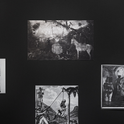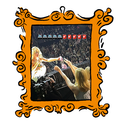"Retinal" was the word Marcel Duchamp used in the early 20th century to disparage painting designed to stimulate the eye rather than the brain. Duchamp's objection was to the kind of painting that had emerged with Courbet and been taken up by the impressionists: painting which shunned literary or religious notions and pursued visual representation for its own sake.
Duchamp abandoned oil painting and then abandoned making or displaying art altogether, preferring instead to play chess and to pursue an oblique but influential role on the margins of New York's art world. His disparagement of retinal art (he also called it "olfactory art," in reference to those painters who fell in love with the smell of oil paint) was grounded not only in his own interest in abstract ideas but in scepticism about the commodification of modern art and the subjective direction in which so much of it seemed to be headed.
At times, Duchamp's attitude revealed an almost scientific disdain for the messiness of artistic subjectivity. He preferred the logician's template, the elegance of chess's closed circuit and the imperious objectivity of mathematics to the subjective stabs in the dark of art.
Taken on his own, Duchamp seems to me to have been a tremendously exciting figure in the history of 20th-century art. But his legacy has had an enervating effect, encouraging artists with weak ideas, and helping to make irony a sine qua non of success in the contemporary art world. Worst of all, Duchamp's emphasis on ideas over "retinal" expression undermined the habit of looking.
Science itself may be the place to seek refuge at this point, in an effort to crack open the all but calcified art world debate between optical effects on the one hand and ideas on the other. By analysing sight, and the way images are processed in the brain, it may be possible to state what artists in the "retinal" tradition have intuited for a long time.
"There is increasing evidence from neuroscience for the extraordinarily rich interconnectedness and interactions of the sensory areas of the brain," wrote Oliver Sacks recently in the New Yorker, "and the difficulty, therefore, of saying that anything is purely visual or purely auditory or purely anything." Sacks describes the "enormous act of analysis and synthesis, the dozens of subsystems involved in the subjectively simple act of seeing."
Yet while this suggests the mingling and mutual reinforcement of sensory information which the greatest paintings harness, it does not necessarily point to the ability of visual imagery to facilitate abstract thought. Are visual images and abstract thought antithetical to each other, or do they feed on, and perhaps even derive from, each other?
It depends, of course, on the responsiveness and the mental faculties of the person in question. Each person, each culture, brings a different eye to art. This obvious point is perhaps best illuminated by the example of Aboriginal art from Australia.
The tradition of Aboriginal painting in acrylics on canvas dates back only to the early 1970s; before then, the Aboriginal visual tradition was kept alive on rocks and impermanent surfaces, such as skin, sand and bark. The intensely coloured painting in acrylics that flourished first on a cattle station called Utopia in central Australia and then boomed across the continent has a distinctly "optical" look, and commentators have tried for years to force connections between it and op artists such as Bridget Riley (one exhibition was even entitled "Ab Op") and abstract expressionists such as Jackson Pollock.
But the greatest Aboriginal paintings are in fact a dizzying combination of cartography, ancestral myth, historical memory and visual invention-all communicated by the simplest, "retinal" means. When the experience of looking at art suggests greatness, it is because the subjectivity of the person looking has found in the image a perfectly fitting hinge for itself to turn around.
This can only happen at a level of the imagination where, as Sacks has it, "there is a continual struggle for concepts and form and meaning... At this level, one can no longer say of one's mental landscapes what is visual, what is auditory, what is image, what is language, what is intellectual, what is emotional-they are all fused together..."
The "retinal" in art is quite as capable of tapping into that realm as the "conceptual," if not more so. Despite its moments of genius, conceptual art too often resembles closed-circuit thinking: thought fortified against imagination.
The Oliver Sacks article I have quoted is about blind people, and why some of them enhance their visual imagination while others seem to lose it altogether. One of Sacks's subjects rails against the "idol worship" of sight, contrasting it to his other, comparatively enhanced senses which, writes Sacks, "blend into a single fundamental sense, a deep attentiveness... a sensuous, intimate being at one with the world which sight, with its quick, flicking, facile quality, continually distracts us from."
The challenge of artists today is to find visual means of reaching beyond the "quick, flicking, facile quality" of sight, and to blend the act of looking with the mind's other faculties into a complete model of the imagination.












